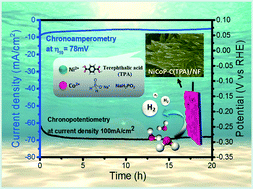Terephthalic acid induced binder-free NiCoP–carbon nanocomposite for highly efficient electrocatalysis of hydrogen evolution reaction†
Abstract
The design and synthesis of electrocatalysts with high efficiency, long-term stability, and low-cost for hydrogen evolution reaction (HER) in the water electrolysis process is urgently desired for large-scale and effective applications of renewable energy. Herein, a binder-free NiCoP–carbon nanocomposite (denoted as NiCoP–C(TPA)) film with a unique nanostructure was fabricated on nickel foam (NF) for the first time by the deposition of a terephthalic acid induced NiCo bimetallic compound precursor film on NF via hydrothermal synthesis, followed by calcination in Ar atmosphere and phosphorization treatment with NaH2PO2. In the obtained NiCoP–C(TPA) electrocatalyst, the bimetallic phosphide nanoparticles were well combined with the graphitic carbon. It was found that the bimetallic NiCo alloy was formed in the carbonization process, which affected the performance of the final catalyst. As a result, the NiCoP–C(TPA) electrocatalyst had a much higher activity than the monometallic phosphides of NiP–C(TPA)/NF and CoP–C(TPA)/NF, and the NiCoP–C(TPA)/NF electrode exhibited an overpotential as low as 78 mV at a current density of 10 mA cm−2 with a small Tafel slope of 73.4 mV dec−1, a faradaic efficiency of ∼94%, and long-term stability at high current densities in an alkaline electrolyte. Meanwhile, the NiCoP–C(TPA)/NF electrode also exhibited superior HER performance in an acidic electrolyte with an overpotential of 94 mV@10 mA cm−2, a Tafel slope of 81.1 mV dec−1, and long-term stability, although in a neutral electrolyte, a relatively high overpotential of 248 mV@10 mA cm−2 with a high Tafel slope of 112.5 mV dec−1 was obtained. It is expected to provide a novel synthetic method by using an organic solid acid to obtain high-performance bimetallic phosphide based electrocatalysts with special nanostructure for HER in the water splitting process.



 Please wait while we load your content...
Please wait while we load your content...